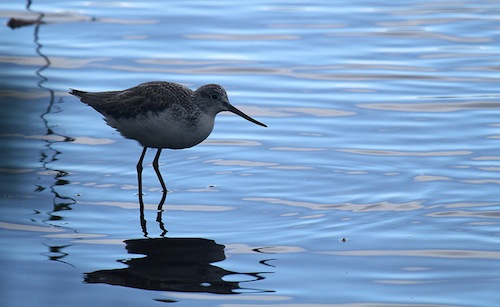 Croft Pascoe Pool on Goonhilly Downs is a great place for spotting migratory and overwintering waders in the autumn, including Greenshanks.
Croft Pascoe Pool on Goonhilly Downs is a great place for spotting migratory and overwintering waders in the autumn, including Greenshanks.
Photo: Ilya Maclean
Scientific name: Tringa nebularia
Other common names: Common Greenshank
Conservation status: IUCN Red List, Least Concern; UK Birds of Conservation Concern, Green.
What to look for:
- Colouring and appearance: Slim, pale grey above in winter and brownish-grey above in summer, pale/white below. Streaking is more prominent in the summer breeding plumage, and the bird has a white rump all year. There is a slight upcurve to the bill, and this, as well as the eponymous long green legs, distinguish it from other similar waders. Males and females look similar, but the females are slightly larger.
- Size: Length 32 cm, wingspan 69 cm.
- Where: Breeding in the northwest of Scotland, round the coast during migration, and in western parts of Britain and in Ireland for the winter.
- Call: A loud “tew-tew” in flight
- Similar species: The Common Redshank and Spotted Redshank, both of which are distinguished from the Greenshank by their red legs.
 The Greenshank can be spotted round most of the UK coastline during migration, but only breeds in the northwest of Scotland. Here in the southwest of the country, we are also fortunate enough to welcome this elegant, medium-sized wader as an overwintering visitor. Greenshanks also stop over for the winter on parts of the west coast of England and Wales, and in Ireland: mainly coastal and estuarine birds, you might also spot them close to lakes and marshy areas inland, or on mudflats when on migration.
The Greenshank can be spotted round most of the UK coastline during migration, but only breeds in the northwest of Scotland. Here in the southwest of the country, we are also fortunate enough to welcome this elegant, medium-sized wader as an overwintering visitor. Greenshanks also stop over for the winter on parts of the west coast of England and Wales, and in Ireland: mainly coastal and estuarine birds, you might also spot them close to lakes and marshy areas inland, or on mudflats when on migration.
A little over 750 individuals overwinter in the UK, with 700 to 1500 pairs breeding further north during the summer. Its overall breeding range is the sub-arctic taiga zone, stretching across northern Europe and Asia. Clutches of three to five eggs are laid in a scrape on dry ground close to water between April and June, and both adults share incubation duties. Juveniles are thought to reach breeding maturity at two years of age.
Did you know…?
…The overwintering territories of the Greenshank extend across western Europe, Africa and Asia, and even to Australia.
…The Greenshank is the largest member of the genus Tringa.
More information and references:
Svensson, L., Mullarney, K., Zetterstrom, D.,1986. Collins Bird Guide, second edition (translated by Christie, D., Svensson, L.). HarperCollins, London.
Published: September 2014
Author: Amanda Scott
Photo: Ilya Maclean
